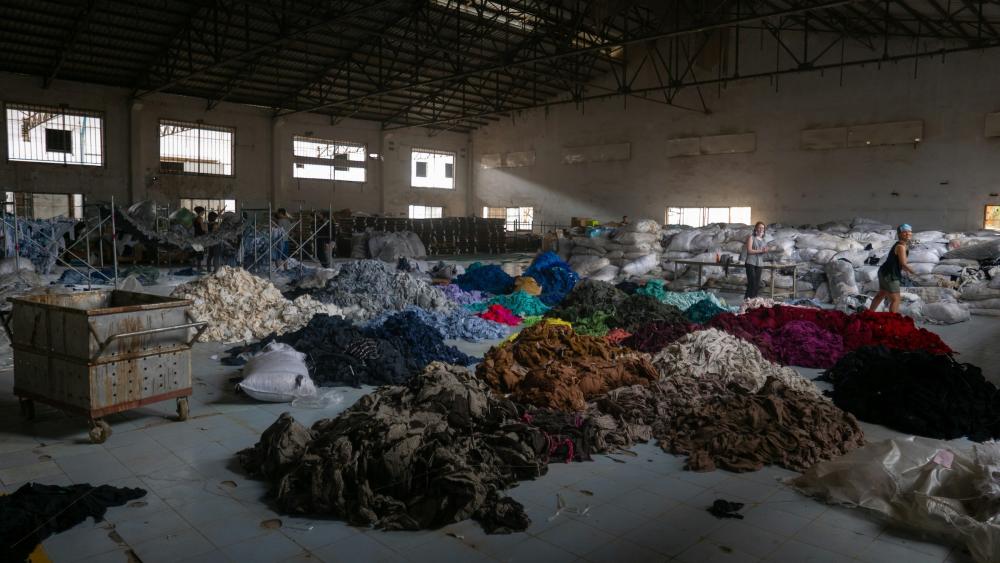Fashion has a deadly reliance on oil. Are biomaterials the solution?


MA student Charlotte Cheal explores fashion's environmental impact, advocating for a shift away from oil-based materials to biomaterials and circular economy models to combat waste and promote sustainability.
The fashion industry detrimentally impacts the environment with a deadly reliance on oil for its materials. The production of synthetic fibres for the textile industry currently accounts for 1.35% of global oil consumption, according to the Changing Markets Foundation 2021. Certain brands deem this figure unacceptable. Those who see synthetic fibres as inappropriate for their clothing actively pursue innovative solutions, forging a path towards future fashion away from oil.
Keeping the status quo to ensure profit
The introduction of biomaterials indicates the right direction, with brands making big investments in new materials like cellulosic yarn and bioglycol, both derived from wood, to make environmentally friendly fibre. Although these innovations are promising, numerous issues persist. Each fibre has its complications. For example, a fibre made with bioglycol still contains around 40% conventional polyester, perpetuating the reliance on oil. Delving deeper, the production of biomaterials highlights how the industry is still focused on producing more as a solution to the problem rather than working with what has already been created
The production of biomaterials highlights how the industry is still focused on producing more as a solution to the problem rather than working with what has already been created.
Therefore, biomaterials are simply a drop-in innovation, an “innovation presented as sustainable and whose objective is the reproduction of the dominant paradigm”, as argued by Befort. For a long time, fashion has focused on producing and selling high quantities of clothing to ensure profit.
The production of biomaterials upholds the production process. According to Befort, sustainable fashion then requires the development of functional innovations, the kinds of “innovations aiming to fulfil equivalent functionalities, from a systemic perspective, favouring low-tech and degrowth options, instead of promising status quo sustainability, thanks to technological change”.
The possibilities of biomaterials
However, this does not render biomaterials as completely counter-productive in sustainable innovation, they instead provide an excellent excuse for potentiality. Ulrich discusses this in their case study on biofuels and the possibilities they allow for, even though they are not a perfect solution to providing renewable energy. She explains these drop-in innovations as promoting a level of sustainability, which might allow more time to “contest existing conditions, relations, and practices” hat are deeply rooted for radical, functional innovations to be explored.
Although Ulrich’s case study explores the promise of biofuels, despite this difference, we can draw parallels between what biofuels and biomaterials allow for in their respective fields in that they both originate from biological sources, typically derived from plants or other renewable resources. Therefore, we can use this study as an example of adequately sustainable biomaterials for the fashion industry.
Fashion has a huge waste problem
Moving forward, it is time to approach fashion's reliance on oil from a different angle, one that is less focused on the seemingly paradoxical idea of creating more materials as a response to the changing climate. Fashion also has a huge waste problem, and utilising this can combat multiple problems together.
An idea I propose here is to work towards a circular economy model that aims to transform products that have reached the end of their useful life into valuable resources for others, thereby closing loops within industrial ecosystems and reducing waste, enabling the full value of clothing to be captured both during and after use. This is something the Slow Factory is channelling the way towards through their Garment to Garment Pilot Program, which looks at waste as a resource in creating new items.
In using the time that biomaterials can afford, brands must look to challenge the status quo of the industry and take up sustainable circular initiatives that build towards a fashion model utilising waste and encourage an authentically sustainable industry away from oil.
Header image credit: No Revisions via Unsplash.
About the author
Charlotte Cheal studies MA Anthropology of Global Futures and Sustainability at SOAS.




